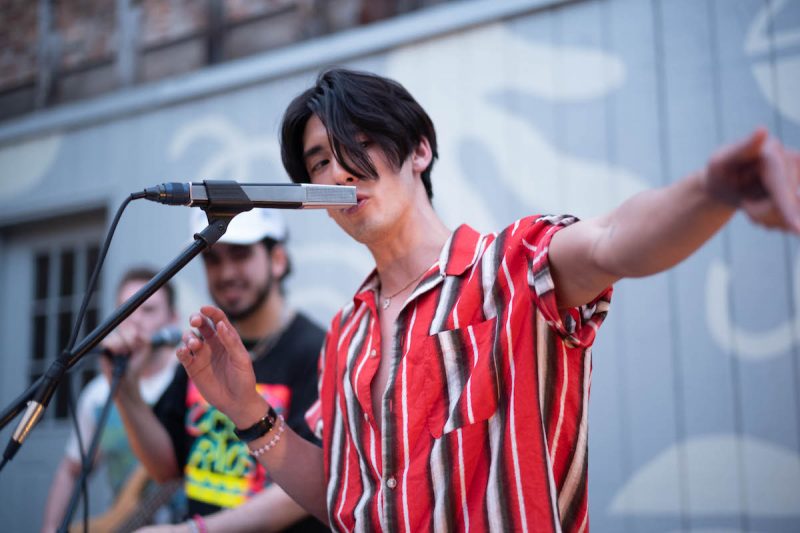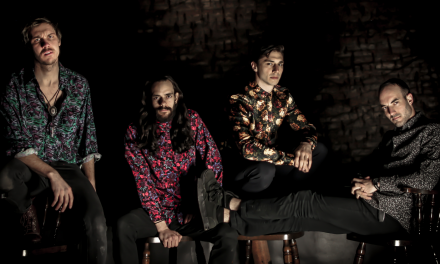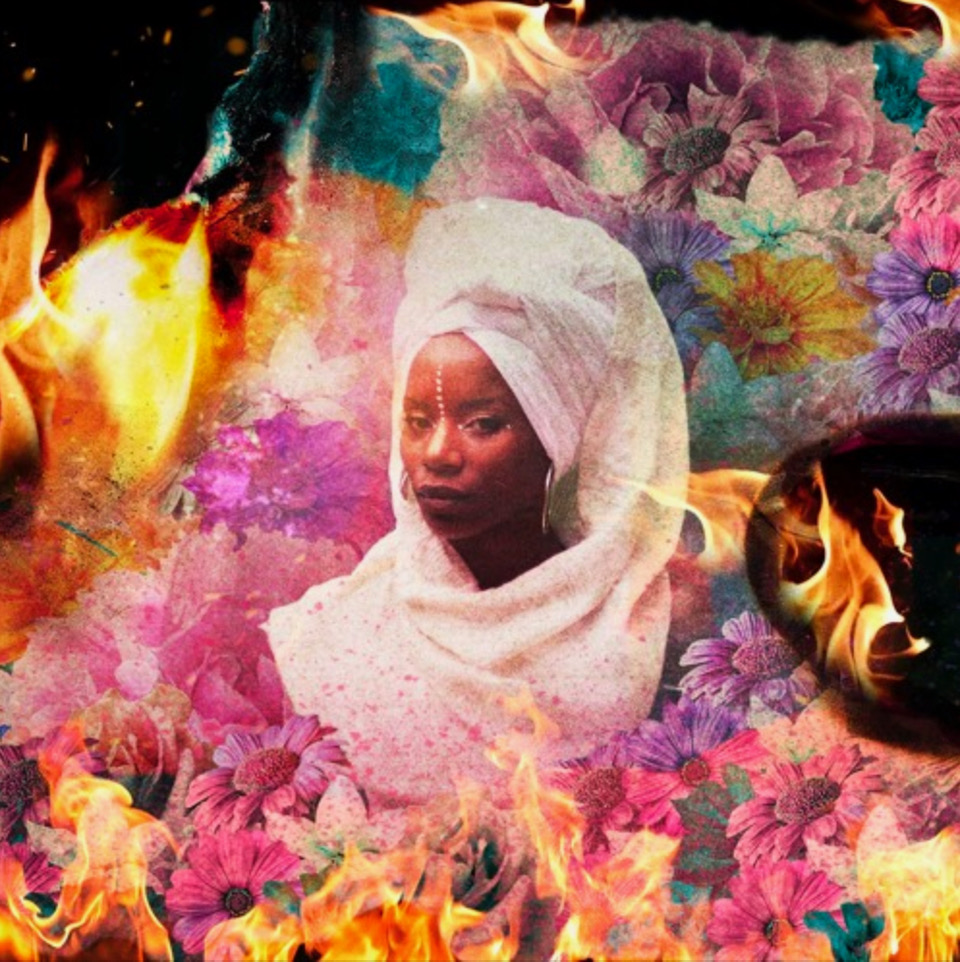Photos by Richard Lovrich. Images of artwork provided by the artist.
On my first true visit to the town of Catskill since the late ‘90s, I meet up with Joe Mama-Nitzberg at HiLo cafe on Main Street. Seeing Nitzberg, a celebrated artist, the former creative director at Geffen, Interscope and Arista here feels a bit like a surrealist painting, an absurdist collage, a glitch in the matrix. This is the guy, after all, who oversaw the creation of album covers for acts like Hole, Outkast, Eminem, Whitney Houston, who has been a confidante of Courtney Love since 1982, a man who worked directly for L.A. Reid.
Kurt Cobain committed suicide when I was 13 and it had a profound impact on me. I read Nitzberg quoted in articles about Love’s mental state in the days after. “She’s truly a product of the world,” Nitzberg is quoted as saying in an Entertainment Weekly article from Aug. 12 titled “Courtney Love Comes Out of Hiding.” He’s identified as “artist Joe Mama, one of Love’s best friends since 1982.”
The last time I was in Catskill for any significant length I was in my late teens. Then the most notable thing about Catskill was the preponderance of fast food joints and the idea that maybe some guys who liked to paint the Hudson River once lived there.
This sensation that something is completely out of the place, that two worlds that should never have met are now fused together by some sort of black magic or cosmic corruption is only exacerbated by Moma-Nitzberg’s enthusiasm for Catskill and his excitement to serve as an advocate for this recently-transformed arts town.
Similarly to that sense of fused realities, it was a set of particular circumstances that informed Nitzberg and his partner Marc Swanson’s decision to move there in 2014. The pair purchased a summer home in Catskill a year or so before Swanson was invited to teach at the Skowhegan School of Painting in Maine.
“I was invited,” recalls Nitzberg “and we realized that our apartment and studios in the city we ’re going to sit empty, we couldn’t sublet them for different reasons and we decided maybe we should just move to the house. We literally just dropped our stuff off on way to Maine, had someone watch the house and our cats and when we came back we realized, ‘Well, we live here now!’ It was really a leap of faith. Now when we look back it was 100 percent the right thing to do, though it is not probably the way I’d suggest other people do it in terms of a plan.”
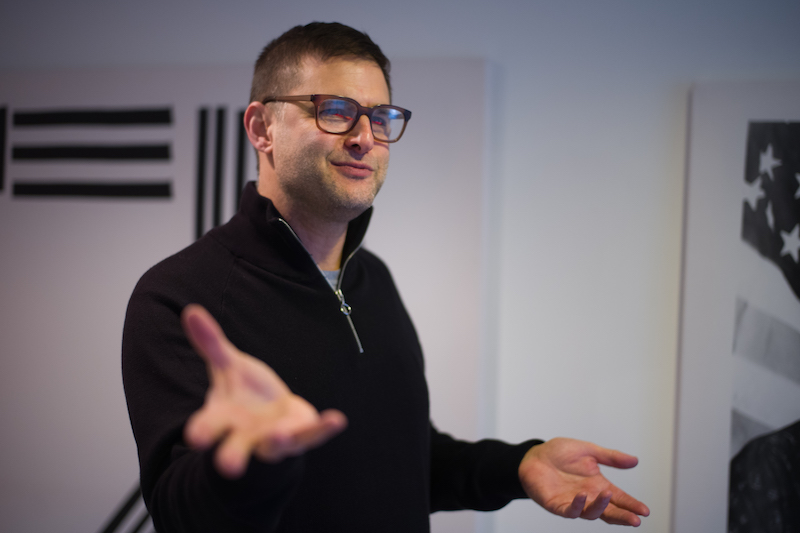
Nitzberg says that as haphazard as his relocation was, it seems that it isn’t exactly atypical. “The people we meet up here who aren’t originally from here but ended up here all have the same kind of story—’We wanted to do it and we figured it out.’ And we continue to figure it out. And during the time so much has changed in the world–technologically, politically culturally, and we’re just so happy to be here through all of that. We have literally never been like ‘We made a mistake!’
Much of Nitzberg’s art juxtaposes visceral, emotional reality, with the distorted, perverted, cheap, hot takes and image filters of the social media age. In “Untitled (Gertrude by Carl with Rainbow)” Nitzberg combines a photo taken of the novelist, art collector, playwright Gertrude Stein by Carl Van Vechten and imposes a stream of rainbow vomit exploding from her mouth. Under the image are the words, “GERTRUDE STEIN BY CARL VAN VECHTEN WITH A HAND-PAINTED “QUOTATION” OF THE RAINBOW SNAP CHAT FILTER THAT MAY SOMEHOW REFERENCE THE PRIDE FLAG WHICH IS AS PROBLEMATIC AS THE AMERICAN FLAG AND PERHAPS YOU COULD ATTRIBUTE A GAY IDENTITY TO VAN VECHTEN AND STEIN BUT ITS ALL JUST VIOLENCE AND IF YOU DON’T GET THAT JUST FROM A QUICK GLANCE THAN YOU ARE THE PROBLEM.”
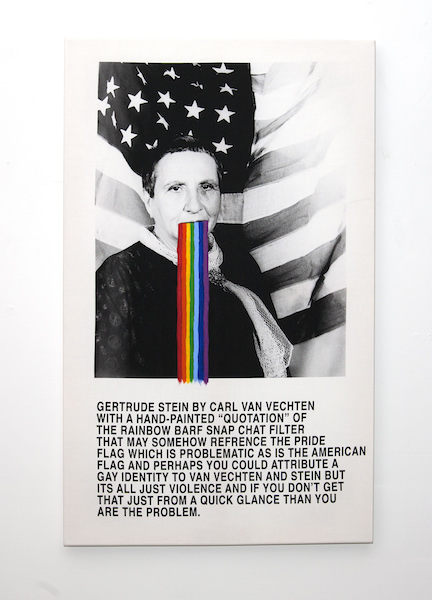
For reference, Van Vechten, a white, married man, photographed the major figures of the Harlem Renaissance wrote a controversial book called “Nigger Haven” that was supposed to be sympathetic to the plight of African Americans at the time. W.E Du Bois said the book’s title was “an affront to the hospitality of black folk.” Van Vechten also carried out three long term gay affairs during his life.
“Untitled” appears to be a comment on the rush to label historical figures as problematic while acknowledging that social media does not allow for a real discussion and analysis of the complexity of the history and the human condition.
Nitzberg’s relocation to Catskill has given him more of a perspective on his relationship with society and the social media era.
“We still feel like just getting to know the area because its vast in terms of what’s going on. I think all of us live more and more online and in our phones and so that I would be in denial I said that wasn’t a huge part of my community and life and where I spend time but I think that also affords us to live wherever want to physically be–where there is more going on culturally. We go out and see a performance here in the last couple of years in the city. I got to a place in the city where I wouldn’t say I was agoraphobic, but it was just I don’t want to deal with it–the train, I can’t afford a car, and it was really bad and I knew it. I was very aware it was stupid but I couldn’t muster up the desire to not stay at home and here it’s just easy to get out. There’s obviously so much less but that’s helpful. You don’t just have to edit, edit, edit and once you edit in the city you’re going to the thing everyone wants to go to and then you are in a fight and competition to do it. Here there is so much stuff going on that I wouldn’t have been open to in the city because it would be too much, or too expensive and we’re much more willing to take a cultural risk, whether at EMPAC or Bar, Basilica Hudson, The Lumberyard, or Art OMI.”
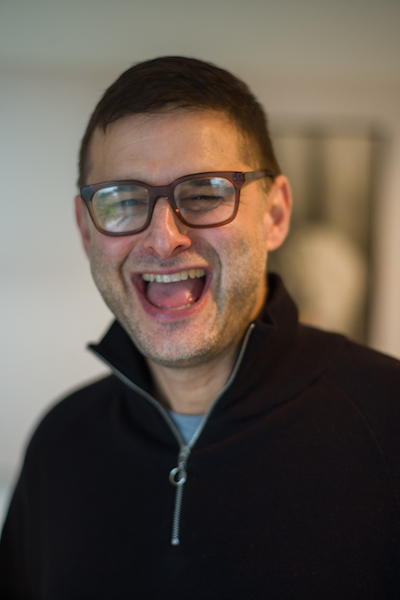
Nitzberg grew up in Santa Clara raised by a progressive Jewish family. He explored the burgeoning local punk scene as a teenager and finally decided to attend art school, he says almost by accident. He graduated from San Francisco State University with a BA in 1989 and earned his Master of Fine Arts from the Art College Center of Design in Pasadena in 1995.
In 1997 by what Moma-Nitzberg describes as a kind of dumb luck he got a job as a creative coordinator at Geffen records. “I finished art school and I was showing art and I kind of had a panic, like ‘I need to get a job’ one of those kinds of panics and I did it and I worked in the music industry for about 8 years and during that time I kind of went up the food chain when that still existed,” Nitzberg says modestly. Industry mergers propelled him up the ranks. And eventually, he moved from LA to NY to work for Arista. “It was a crazy 7 to 8 year run as the industry was running toward the digitization cliff and then went over. I got to work with incredible people.”
Asked about the work he is most proud of in that role Nitzberg pauses and seems to drift. “ I think the things I felt stand test of time the best would be Outkast’s Speakerboxxx/Love Below. Obviously, they were extremely creative and it was my job to corral them, focus them and help them realize these great big ideas into something manageable. That was always through diplomacy and direction. I’m actually really proud of the work on Eminem’s Marshall Mathers project. And although it wasn’t necessarily the most visually incredible thing I got to work with Aretha Franklin on her record. I mean, Hole was pretty amazing,” says Nitzberg, drifting a bit as if bits of that 8-year frenzy are flashing before his eyes. “I’m not so good with my resume,” he smiles and chuckles.
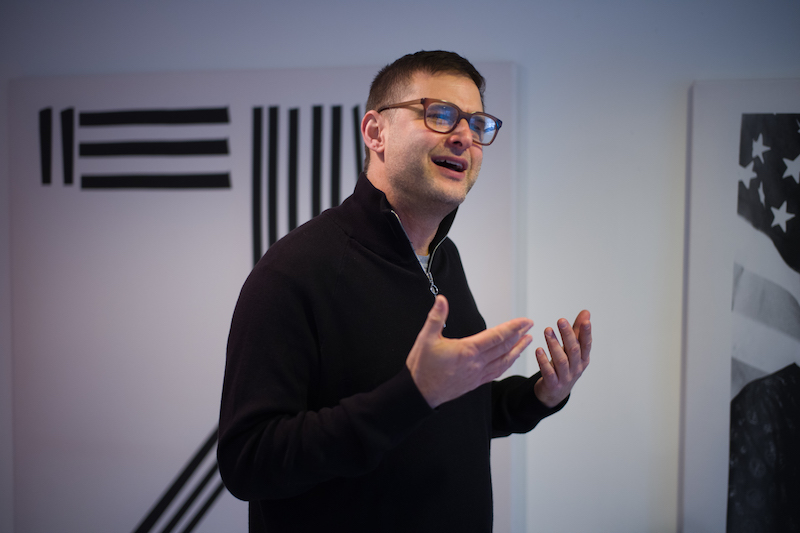
Nitzberg treats his time in the major label world as an aberration, a happy accident that he was caught up in, a wave he rode happily but left him a little bit off track when it finally crashed back into the sea.
Rather than pursuing the creation of his own work, Nitzberg continued to take work that empowered and guided other artists’ creative decisions. Nitzberg shares a gallery in Catskill with his partner Swanson. Nitzberg says that early in their relationship, Swanson told him that it was clear he was ready to focus on his own art. Nitzberg says he wasn’t so sure but he began recapturing his voice as a creative.
What finally brought the pair to Catskill is directly connected to Nitzberg’s work in the music industry. “Melissa is super inspirational to us. She is why we moved up here,” says Nitzberg of Melissa Auf der Maur of Basilica Hudson. “In her inimitable way, she gave us this quick tour one afternoon of Basilica, her commitment, and vision, and we ’re just like, ‘We haven’t seen anyone doing anything like this in a while and this is what we’re doing now.’ It wasn’t like halfway. From the start she made us feel ‘We can go for it too!’”
The former spa/salon where the pair creates still bears markers of its past life but the bright EXIT signs and promotional stickers for various self-care products are magnificently overshadowed in the upper floor which houses Swanson’s sharp white sculptures.
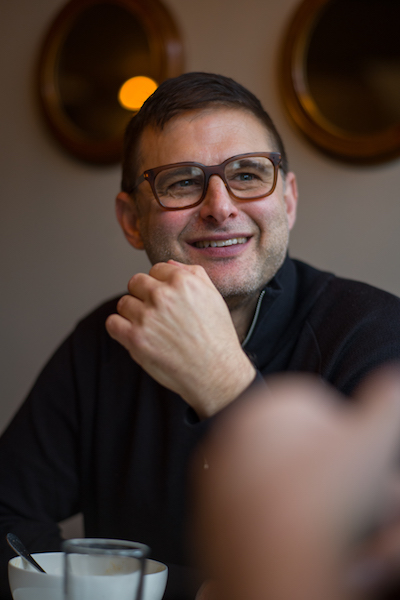
Joseph Nizberg in his Catskill NY studio/gallery and a local eaterie.
Those quirky leftovers almost accent Nitzberg’s work that hangs on the bottom floor. Nitzberg’s work with collage and photography conveys that same feeling of unease, the uncertainty that worlds, concepts, thoughts that were never supposed to meet now have been fused together inextricably.
The most striking work in Nitzberg’s space seems almost benign at first. It blends into the white of the studio walls almost as if it is trying not to be seen. On closer inspection “B.A.R.” is a striking commentary on how we process horror, grief and the suffering of others.
Nitzberg describes watching as a local gay paper dedicated more and more of its editorial space to desperate and sincere obituaries written by the families of men who had died of AIDS. He recalls, despite being gay, that it didn’t impact him then as he feels it should have now.
He points out how personal and touching the tributes to these dead men are. How they feel real, human, accented with elements of human and marked by mistakes made in the rush to just tell the person’s story. The enormity of the situation is now overwhelming to Nitzberg and he conveys that by painting over the names of the men–perhaps to spotlight that despite being loved and accomplished people they were eventually forgotten, that their plight at the time was in many ways ignored by those in power, and by those who simply didn’t want to allow themselves to be overwhelmed by the sheer horror of the AIDS crisis.
It also hearkens to the anonymity and triteness of social media. How moments of tremendous grief, pain, emergency, terror, entire lives are summarized now in 280 characters and then forgotten as quickly as they are posted.
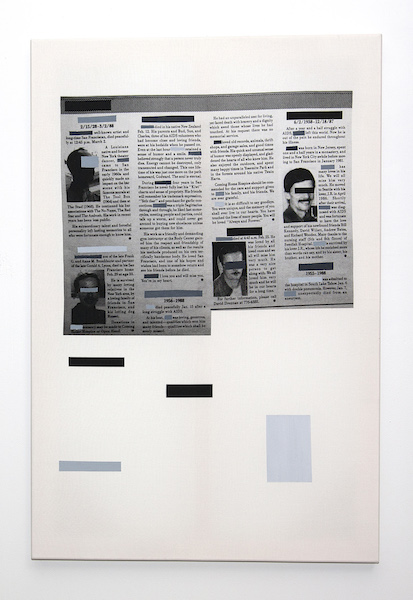
In October of last year, Nitzberg worked with Melissa Auf der Maur to honor his old friend Courtney Love as part of a fundraiser for Basilica Hudson. The effort involved the support of creative organizations and creatives from all over the region. Nitzberg took center stage as a co-host with Auf der Maur. Here his old life and new life combined. Michael Stipe sent a video message, as did major designers. Love and Melissa reminisced about their days on tour and Love recalled working with Nitzberg for the album shoot for Celebrity Skin.
The event was emotional for me, to see this person and art movement that had so much impact on me as a young child celebrated in a place that I grew up in felt unreal, it nearly brought me to tears.
Nitzberg admits that there was uncertainty about how things might go with Love’s unpredictable, raucous nature, (“The reason we all love her”) he notes. He was unsure how Melissa and Courtney who are in totally different places in their lives–and who had not been in close contact–might interact. But when I press him on how it impacted him he is less focused on a past that he frames, at times, as a result of dumb luck and more interested in discussing the future–one where he lives in a place he loves, full of art to create and discover.
We place our cups in the bus box and exit HiLo. We then stroll Main Street as Nitzberg gives me the lay of the land, describing his friends, the work of local artists he admires, the studios he visits, the quirks of a local merchant. When Nitzberg talks about the past it feels covered in a fog, disconnected, obscured and out of place, he sounds almost apologetic. When he talks about his home he comes across as present alive and in love.


